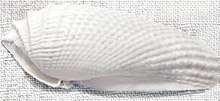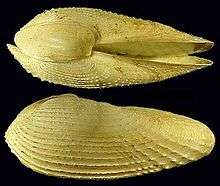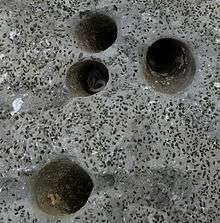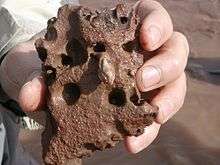Pholadidae
Pholadidae, known as piddocks or angelwings, are a family of bivalve molluscs similar to a clam.
| Pholadidae | |
|---|---|
 | |
| One valve of a shell of Cyrtopleura costata | |
| Scientific classification | |
| Kingdom: | Animalia |
| Phylum: | Mollusca |
| Class: | Bivalvia |
| Subclass: | Heterodonta |
| Order: | Myida |
| Superfamily: | Pholadoidea |
| Family: | Pholadidae Lamarck, 1809 |
| Genera | |
|
See text | |
Background
Piddocks are unique in that each side of their shells is divided into 2 or 3 separate sections. Furthermore, one of the piddock's shells has a set of ridges or "teeth", which they use to grind away at clay or soft rock and create tubular burrows. The shape of these burrows are due to the rotating motion of the piddock as it grinds the rock to make its home. The piddock stays in the burrow it digs for the entirety of its eight-year lifespan, with only its siphon exposed to take in water that it filters for food. When the piddock dies and leaves an empty tubular burrow, other marine life such as sea anemone, crabs and other molluscs may use the burrow.
Some species of Pholadidae may reach up to 18 cm (7″). Their coloration is typically white, though through consumption of red tide algae some may develop a pink coloration.
- The angelwing species Cyrtopleura costata has approximately 26 radiating ribs. Growth lines run horizontally over the surface of the shell. Angelwings have a spoon-shaped brace under the beak of the shell, called the apophysis, where the mollusc's foot muscles are attached. Cyrtopleura costata possesses long siphons which protrude from its burrow and circulate water as the source for its food supply. It cannot retract its siphons into the protection of its shell, so the two valves can never shut completely. The muscles fusing the shell's valves together are weak, making it rare to find angelwings with both halves still intact. Some shell hunters dig for the living clam, and if dug up, the fragile shell must be placed immediately into a container of water or it will close and shatter. The angelwing's shell is popular with collectors, as well as a delicious food staple. The angelwing lives offshore and in estuaries, sometimes as much as a metre (three feet) deep in the mud or clay.
- The Atlantic mud-piddock, Barnea truncata, often referred to as the fallen angelwing, is classed among the angelwing varieties, growing up to 5.7 cm (2¼″) and is similar to other angelwings but with weaker sculpture. One end is squared off and the other end pointed. Loose accessory plates are located above the hinge on live specimens. It possesses a white exterior and interior. It burrows into mud, clay or softwood. Occasionally it is washed onto sounds and ocean beaches, and has a habitat range from Nova Scotia to Brazil. This fragile shell is rarely dug from mud without breaking. It burrows deeply and has long, united siphons.
- The false angelwing Petricola pholadiformis, is also classed among varieties of angelwing, growing up to 7 cm (2¾″). It has a thin, elongate shell resembling a small angelwing but lacks the rolled-out hinge area. Its beak is at one end of the shell with strong radial ribbing on the beak end. Teeth are located on hinge and a deep pallial sinus and partially united siphons. It has a white exterior and interior. It typically burrows into hard surfaces such as clay or peat in intertidal zones. It is commonly found on sounds and ocean beaches with a range from Canada to Uruguay.
- The common piddock (Pholas dactylus) is known for its bioluminescence[2][3] and was investigated by Raphaël Dubois in his 1887 discovery of luciferin.
Genera and selected species

- Genus Barnea Risso, 1826
- Barnea candida Linnaeus, 1758
- Barnea fragilis
- Barnea manilensis (Philippi, 1847)
- Barnea parva Pennant, 1777
- Barnea similis (Gray, 1835)
- Barnea subtruncata (G. B. Sowerby I, 1834)
- Barnea truncata (Say, 1822)
- Genus Chaceia Turner, 1855
- Chaceia ovoidea (Gould, 1851)
- Genus Cyrtopleura Tryon, 1862
- Genus Diplothyra Tryon, 1862
- Diplothyra smithii Tryon, 1862
- Genus Jouannetia Desmoulins, 1828
- Jouannetia quillingi Turner, 1955
- Genus Martesia G. B. Sowerby I, 1824
- Genus Netastoma Carpenter, 1864
- Netastoma japonicum (Yokoyama, 1920)
- Netastoma rostratum (Valenciennes, 1846)
- Genus Nettastomella Carpenter, 1865
- Nettastomella darwini (Sowerby, 1849)
- Genus Parapholas Conrad, 1848
- Parapholas californica (Conrad, 1837)
- Genus Penitella Valenciennes, 1846
- Penitella conradi Valenciennes, 1846
- Penitella fitchi Turner, 1955
- Penitella gabbii (Tryon, 1863)
- Penitella hopkinsi Kennedy and Armentrout, 1989
- Penitella kamakurensis (Yokoyama, 1922)
- Penitella penita (Conrad, 1837)
- Penitella richardsoni Kennedy, 1989
- Penitella turnerae Evans and Fisher, 1966
- Genus Pholadidea Turton, 1819
- Pholadidea acherontea Beu and Climo, 1974
- Pholadidea loscombiana Turton, 1819
- Pholadidea spathulata (Sowerby, 1850)
- Pholadidea tridens (Gray, 1843)
- Genus Pholas Linnaeus, 1758
- Pholas campechiensis Gmelin, 1791
- Pholas dactylus Linnaeus, 1758 – common piddock
- Genus Xylophaga Turton, 1822
- Xylophaga abyssorum Dall, 1886
- Xylophaga atlantica Richards, 1942
- Xylophaga dorsalis (Turton, 1819)
- Xylophaga praestans E. A. Smith, 1903
- Xylophaga washingtona Bartsch, 1921
- Genus Xyloredo Turner, 1972
- Xyloredo naceli Turner, 1972
- Xyloredo nooi Turner, 1972
- Genus Zirfaea Gray, 1842
Gallery
 Valves of the Atlantic mud-piddock or fallen angelwing, Barnea truncata
Valves of the Atlantic mud-piddock or fallen angelwing, Barnea truncata.jpg)
 burrows, 2.5 cm (1″) or less, in calcic rock, coast Boulogne - Calais (France)
burrows, 2.5 cm (1″) or less, in calcic rock, coast Boulogne - Calais (France) Angelwing and associated burrows
Angelwing and associated burrows
| Wikimedia Commons has media related to Pholadidae. |
See also
References
- http://www.registrelep.gc.ca/virtual_sara/files/cosewic/sr_Atlantic%20Mud-piddock_0810_e.pdf
- Basic information for Pholas dactylus (Common piddock)
- Vincent Pieribone and David F. Gruber. Aglow in the Dark: The Revolutionary Science of Biofluorescence. Harvard University Press, 2005.
